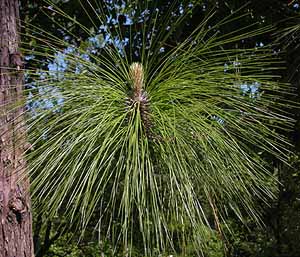 Longleaf Pine
Longleaf Pine
Pinus palustris Mill. (Pinaceae)
Common Names
Longleaf pine, fat pine, Georgia pine, hard pine, heart
pine, longleaf yellow pine, longstraw pine, pitch pine, rosemary pine, southern
pine, southern yellow pine, turpentine pine, yellow pine.
Description
Longleaf pine is a long-lived, native, evergreen conifer with course, scaly bark.
Needles are a distinctive characteristic;
they are in bundles of 3, shiny, dark green, and 8 to 15 inches long.
Cones are 6 to 10 inches long, and somewhat cylindrical.
Mature trees attain a height of 100 to 120 feet and
2 1/2 feet in diameter. Its seeds are the largest of all southern pines.
It has extensive lateral roots and a taproot that grows 8 to 12 feet long.
Young form of tree is columnar, unbranched, and has a very leafy trunk.
Flowering Period
March to April.
Range
Longleaf pine, is found in the Atlantic and Gulf
coastal plains from southeastern Virginia to central Florida and west to eastern
Texas, and in the Piedmont region and Valley and Ridge province of Georgia and
Alabama.
Adaptation
Longleaf pine grows best in a warm, wet, temperate climate with an annual
precipitation range of 43 to 69 inches. Although the species occurs in a
wide variety of upland and flatwood sites, it is common on sandy, infertile,
well-drained soils, mostly below 660 feet elevation.
Harvest
Sap in early April, and gum about last of April or first of May.
Duration
Evergreen.
Family
Pine.
Establishment
Longleaf pine stands are successfully established by either seeding or
vegetative reproduction. Seeds (including dormant seeds if prechilled) can
be sown in the fall or spring, pressed into the soil at densities from 15 to 75
seedlings per square foot. Seeds germinate 1 to 2 weeks following seedfall.
Germination requires mineral soil. The seed's large size and persistent wing
prevent it from penetrating through the litter. Seedlings are stemless after
one growing season and this lasts from 2 to many years. During this grass-stage,
the seedling develops an extensive root system, and the root collar increases in
diameter. When the root collar diameter approaches 1 inch in diameter, height
growth begins. A field-grown seedling grows 10 feet in 3 years once height growth
is initiated. Branch production is delayed until the seedling reaches 10 to 16
feet in height.
Vegetative propagation is usually done by grafting. If grass-stage seedlings are top-killed, they can sprout from the root collar. Once height growth begins, sprouting ability decreases rapidly.
Heavy grazing can reduce tree density, significantly reducing establishment and causing crop failure.
Uses
Erosion Control: Longleaf pine is a highly recommended species for reforestation
of dry, infertile, deep sands in the southeastern U.S. It is has limited
potential for rehabilitation of mine spoils.
Wildlife: Birds and small mammals eat the large seeds, ants feed on germinating seeds, and razorback hogs eat the roots of seedlings. This species provides excellent habitat for bobwhite quail, white-tailed deer, wild turkey, and fox squirrel. Old-growth stands provide nesting habitat for the red-cockaded woodpecker.
Timber: The wood is often clear, straight, and with few defects and used for timber and ship building.
Recreation and Beautification: Longleaf Pine is a source of turpentine, pine oil, tar, pitch, resins and wood pulp. It is used in the manufacturing of varnishes, inks, waxes, seals and lubricants, as well as kraft paper and paperboard. The needles are used for mulch. Resin is used in the naval stores industry for gum turpentine and rosin production. The uses of turpentine oil as a rubefacient are well known. Rosin is widely used by athletes to protect their hands, and by violinists to prevent the bow from slipping and to produce better vibration. Pine tar from this source is used therapeutically for the same purpose as white pine tar.
Management
Longleaf pine is intolerant to both shade and competition. With frequent
fire, uneven-aged pure stands form park-like savannahs. Because longleaf
pine regenerates in openings created by dead trees, small clusters of trees
of the same age are dispersed throughout the stand. In the absence of
frequent fire, the species is replaced by hardwoods and other southern pines;
this hastens the decline of mature longleaf pine. Lightning ignited fires
are pivotal to perpetuation of longleaf pine on a site indefinitely.
Excessive grazing reduces young tree density.
Pests and Potential Problems
The main disease of longleaf pine is brown-spot needle blight (Scirrhia
acicola). Other diseases include pitch canker, annosus root rot, and cone
rust. Insects that attack longleaf pine include black turpentine beetle,
bark beetles, and seed bugs.
Cultivars, Improved, and Selected Materials (and area of origin)
No cultivars are currently recommended. Seeds and seedlings are
commercially available from woody plant seed companies. The number
of seeds per pound ranges from 3,000 to 7,000.
(Information adapted from USDA NRCS National Plant Data Center Baton Rouge, LA)